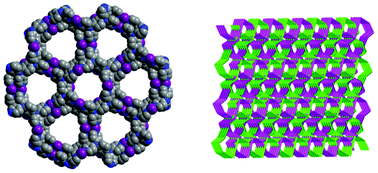The coordination of Zn(II), Ag(I), Cu(II), Cu(I) and Co(II) salts with N,N,N′,N′-tetrakis(4-pyridyl)-1,4-phenylenediamine (L) generated seven novel supramolecular coordination assemblies, {[CuI6L3Cl6]·3MeCN}n (1), {[CuI2LCl2]·2DMSO}n (2), {[CuILI]}n (3), {[Zn2L(HCOO)4]}n (4), {[Ag4L2(N3)4]·2H2O}n (5), {[Co4L2(SO4)4(H2O)12]·2CH3CN}n (6) and {[CuL(CH3COO)2(H2O)2]·2MeOH}n (7). In complexes 1 and 2, the Cu(II) atoms have been converted to Cu(I). Complexes 1, 4 and 5 show 1D or 2D coordination structures, and all of them are further linked by π⋯π stacking interactions to afford 3D structures. Complex 2 has a 2D structure composed of Cu2Cl2 units and L ligands. Complex 3 exhibits a doubly interpenetrated 3D structure. In complex 6, the 2D coordination networks are further linked by hydrogen bonds to afford a 3D supramolecular structure. Similar to complex 6, the 1D chains in complex 7 are assembled into a 2D network through hydrogen bonds. Based on the novel structures, the solid state luminescent properties of the complexes were investigated and discussed.

